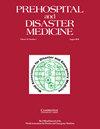紧急医疗服务中机器学习算法的应用和性能:范围审查。
IF 2.1
4区 医学
Q2 EMERGENCY MEDICINE
引用次数: 0
摘要
本研究旨在总结有关机器学习(ML)在紧急医疗服务(EMS)中的应用及其性能的文献。方法检索了四个相关的电子数据库(从开始到 2024 年 1 月),以查找所有采用 EMS 指导的 ML 算法来提高 EMS 临床和操作性能的原创研究。两名审稿人对检索到的研究进行了筛选,并从纳入的研究中提取了相关数据。对纳入研究的特征、采用的 ML 算法及其在主要领域和子领域的性能进行了量化描述。其中,125 项研究关注临床领域,39 项研究关注操作领域。ML算法的特征,如样本大小、输入特征的数量和类型以及性能,在不同应用领域和子领域之间和内部都有所不同。ML 算法的临床应用涉及分流或诊断分类(62 例)、治疗预测(12 例)或临床结果预测(50 例),主要用于院外心脏骤停/OHCA(62 例)、心血管疾病/CVD(19 例)和创伤(24 例)。这些 ML 算法的性能各不相同,接收器工作特征曲线下的中值面积 (AUC) 为 85.6%,准确率为 88.1%,灵敏度为 86.05%,特异性为 86.5%。在运行研究中,大多数 ML 算法的运行任务是救护车分配(21 例),其次是救护车检测(5 例)、救护车部署(5 例)、路线优化(5 例)和质量保证(3 例)。所有运行 ML 算法的性能各不相同,其 AUC 中位数为 96.1%,准确率为 90.0%,灵敏度为 94.4%,特异性为 87.7%。一般来说,神经网络和集合算法在一定程度上优于其他 ML 算法。未来的报告应侧重于特定的临床条件或操作任务,以提高 ML 模型性能指标的精确性。本文章由计算机程序翻译,如有差异,请以英文原文为准。
Applications and Performance of Machine Learning Algorithms in Emergency Medical Services: A Scoping Review.
OBJECTIVE
The aim of this study was to summarize the literature on the applications of machine learning (ML) and their performance in Emergency Medical Services (EMS).
METHODS
Four relevant electronic databases were searched (from inception through January 2024) for all original studies that employed EMS-guided ML algorithms to enhance the clinical and operational performance of EMS. Two reviewers screened the retrieved studies and extracted relevant data from the included studies. The characteristics of included studies, employed ML algorithms, and their performance were quantitively described across primary domains and subdomains.
RESULTS
This review included a total of 164 studies published from 2005 through 2024. Of those, 125 were clinical domain focused and 39 were operational. The characteristics of ML algorithms such as sample size, number and type of input features, and performance varied between and within domains and subdomains of applications. Clinical applications of ML algorithms involved triage or diagnosis classification (n = 62), treatment prediction (n = 12), or clinical outcome prediction (n = 50), mainly for out-of-hospital cardiac arrest/OHCA (n = 62), cardiovascular diseases/CVDs (n = 19), and trauma (n = 24). The performance of these ML algorithms varied, with a median area under the receiver operating characteristic curve (AUC) of 85.6%, accuracy of 88.1%, sensitivity of 86.05%, and specificity of 86.5%. Within the operational studies, the operational task of most ML algorithms was ambulance allocation (n = 21), followed by ambulance detection (n = 5), ambulance deployment (n = 5), route optimization (n = 5), and quality assurance (n = 3). The performance of all operational ML algorithms varied and had a median AUC of 96.1%, accuracy of 90.0%, sensitivity of 94.4%, and specificity of 87.7%. Generally, neural network and ensemble algorithms, to some degree, out-performed other ML algorithms.
CONCLUSION
Triaging and managing different prehospital medical conditions and augmenting ambulance performance can be improved by ML algorithms. Future reports should focus on a specific clinical condition or operational task to improve the precision of the performance metrics of ML models.
求助全文
通过发布文献求助,成功后即可免费获取论文全文。
去求助
来源期刊

Prehospital and Disaster Medicine
Medicine-Emergency Medicine
CiteScore
3.10
自引率
13.60%
发文量
279
期刊介绍:
Prehospital and Disaster Medicine (PDM) is an official publication of the World Association for Disaster and Emergency Medicine. Currently in its 25th volume, Prehospital and Disaster Medicine is one of the leading scientific journals focusing on prehospital and disaster health. It is the only peer-reviewed international journal in its field, published bi-monthly, providing a readable, usable worldwide source of research and analysis. PDM is currently distributed in more than 55 countries. Its readership includes physicians, professors, EMTs and paramedics, nurses, emergency managers, disaster planners, hospital administrators, sociologists, and psychologists.
 求助内容:
求助内容: 应助结果提醒方式:
应助结果提醒方式:


